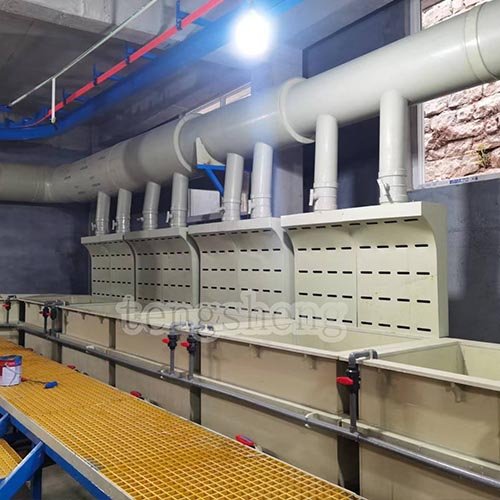Manual equipment

Introduction to Manual Electroplating Lines
Manual electroplating lines are basic, cost-effective systems used for small-scale or specialized electroplating operations. These systems rely heavily on human intervention for loading, unloading, and transferring workpieces between tanks. They are widely used in workshops, laboratories, or small businesses where automation is not necessary or feasible. Despite their simplicity, manual electroplating lines can deliver high-quality finishes when operated correctly.

Overview of Manual Electroplating Lines
Manual electroplating lines consist of a series of tanks or stations arranged in sequence, each dedicated to a specific process such as cleaning, plating, rinsing, and drying. Operators manually move workpieces between these stations using hooks, racks, or other handling tools. The system is highly flexible and can be customized to suit specific plating requirements, making it ideal for small-batch production or prototyping.

Introduction to Manual Cleaning Lines in Electroplating
Manual cleaning lines are an essential part of the electroplating process, designed to prepare workpieces for plating by removing contaminants such as oils, grease, rust, and other surface impurities. These systems rely on manual handling and basic equipment, making them cost-effective and suitable for small-scale operations or workshops. Manual cleaning lines are often used in conjunction with manual electroplating systems to ensure high-quality finishes.

Introduction to High-Track Manual Electroplating Equipment
High-track manual electroplating equipment is a specialized setup designed for small-scale operations, workshops, or laboratories. These systems are characterized by their elevated track design, which allows workpieces to be manually moved along an overhead rail system through various stages of the electroplating process. This design minimizes floor space usage and provides better organization of tanks and stations. High-track manual systems are ideal for businesses that require flexibility, affordability, and ease of operation without the complexity of fully automated systems.

Introduction to Small-Scale Gold and Silver Plating Equipment
Small-scale gold and silver plating equipment is designed for businesses, workshops, or hobbyists who need to apply precious metal coatings to small workpieces. These systems are compact, cost-effective, and easy to operate, making them ideal for jewelry making, electronics, prototyping, or custom projects. Gold and silver plating provides aesthetic appeal, corrosion resistance, and enhanced conductivity, making it widely used in industries such as jewelry, electronics, and decorative arts.

Introduction to Manual Electroplating Equipment for Neodymium-Iron-Boron (NdFeB) Magnets
Neodymium-Iron-Boron (NdFeB) magnets are widely used in industries such as electronics, automotive, renewable energy, and medical devices due to their exceptional magnetic properties. However, these magnets are highly susceptible to corrosion, requiring protective coatings through processes like electroplating. Manual electroplating equipment for NdFeB magnets is designed to apply durable and uniform metal coatings (e.g., nickel, zinc, or copper) to enhance their corrosion resistance and durability.

Introduction to High-Track Manual Electroplating Equipment
High-track manual electroplating equipment is a specialized setup designed for small-scale operations, workshops, or laboratories. These systems are characterized by their elevated track design, which allows workpieces to be manually moved along an overhead rail system through various stages of the electroplating process. This design minimizes floor space usage and provides better organization of tanks and stations. High-track manual systems are ideal for businesses that require flexibility, affordability, and ease of operation without the complexity of fully automated systems.

Introduction to Manual Barrel (Roll) Plating Equipment
Manual barrel plating equipment, also known as roll plating or tumbling plating systems, is a cost-effective and versatile solution for electroplating small to medium-sized parts in bulk. These systems use rotating barrels or drums to tumble workpieces during the plating process, ensuring uniform coating coverage. Manual barrel plating is widely used in industries such as automotive, electronics, hardware, and jewelry manufacturing due to its ability to handle large quantities of small components efficiently.

Introduction to Tilted Manual Barrel (Roll) Plating Equipment
Tilted manual barrel plating equipment is a specialized type of small-scale electroplating system designed for efficient and uniform coating of small parts. Unlike traditional horizontal barrel systems, tilted barrel plating equipment operates with the barrel positioned at an angle, allowing for better fluid circulation and more consistent exposure of workpieces to the electrolyte solution. This design is particularly useful for delicate or irregularly shaped parts that require precise and even coatings.

Overview of Manual Electroplating Lines
Manual electroplating lines consist of a series of tanks or stations arranged in sequence, each dedicated to a specific process such as cleaning, plating, rinsing, and drying. Operators manually move workpieces between these stations using hooks, racks, or other handling tools. The system is highly flexible and can be customized to suit specific plating requirements, making it ideal for small-batch production or prototyping.
